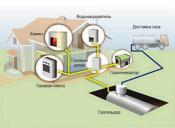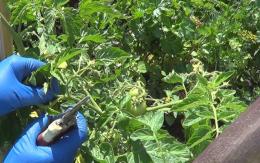Search
Login
Recommended
Outdoor tomato cultivation, outdoor cultivation tomato
Traditionally, in the summer, one of the main foods is fresh vegetables and fruits. Fresh cabbage, onion, radish, cucumber and tomato salads are a must on the daily menu. But only the vegetables purchased in the store often turn out to be grown in greenhouse conditions, they do not differ in rich aroma, the real natural taste of the agricultural product is formed under the influence of sunlight, dew at night, daily temperature drops - each of the natural factors has its own influence on the formation and maturation process fetus.
The way out is the purchase of natural vegetable products or their independent cultivation on a personal plot. But to get a crop that can fully provide the family with tasty vegetables for the whole year, you will need to know some secrets, modern developments of biologists and agronomists will be useful, it will not be amiss to recall the advice of experienced summer residents.
Content:
- Tomatoes in the open ground - organization of irrigation
- Topping Tomatoes video
- Ovary - a stimulator of fruit formation, reviews on effectiveness video
- Stitching tomato - what is it video
- Schemes and dates
- Paschinkovanie tomato in the open ground, step by step video
- Useful Tips
Tomatoes, cultivation and care in the open field, the organization of irrigation
The first thing a plant needs for normal fruiting is moisture. Correct and timely watering, in particular during the flowering and fruit formation period, most often turns out to be the decisive moment determining the quantity and quality of the future crop.

The recommended moisture rate for application is about 10 liters per square meter of area of \u200b\u200btomato beds.
A lack of water can lead to:
- falling ovaries
- twisting leaves
- chopping fruit
- fruit damage with apical rot
Tomatoes are classified as drought-tolerant plants; excess moisture is also problematic for them, as well as its lack, i.e. watering should not be excessive. Overmoistening provokes excessive build-up of green mass, which, quite naturally, inhibits the onset of early ripening of fruits.

In addition, moisture on the stem or leaves can lead to the development of fungal diseases.
Experienced summer residents recommend in case of drought during flowering to water tomatoes at the rate of 1 liter of water per bush, once a week, the water should be warm.
During the formation of the fruit of the water, more is required watering is advisable to make more often. After watering, the soil around the plants needs to be loosened, stubs should be earthed. The depth of cultivation should not exceed 5-8 cm, otherwise - you risk damaging the roots.
Topping tomatoes in open ground
No less important role in obtaining a quality product is top dressing. They can be combined with watering, the following recipe can be considered optimal, the calculation is carried out on a bucket of water:
- 50 gr of ammofoski or double superphosphate
- 45 g of urea
- 40 grams of ammonium sulfate (replacement - 20 grams of potassium salt, you can - 20 grams of potassium chloride and 100 grams of wood ash).
A bucket of such a mixture will be enough to fertilize about 20 bushes, the frequency of application is once every two weeks.

For the second top dressing, you need to dissolve in a bucket of water:
- double superphosphate - from 60 to 80 g
- urea - about 25 g
- potassium salt from 40 to 50 g (can be replaced with potassium chloride and 300 g of wood ash)
The mixture is introduced into specially dug holes, the distance from which to the tomato trunk should be about 20 -25 cm. After making the solution, the pits should be covered with dry soil, the row spacing should be weeded.
Organic fertilizers are traditionally used as fertilizers for tomatoes in the form of:
- slurry
- mullein
- bird droppings

Diluted mullein and slurry are diluted with water 1: 6, bird droppings - 1:15, while it is recommended to add mineral fertilizers to each bucket:
- wood ash (0.5 g)
- boric acid (0.3 g)
- 50 g superphosphate
- 0.3 g manganese sulfate
We divide the bucket into 20 bushes of tomatoes.
Feeding time can be determined by observing the plants:
- with slow growth and pallor of the leaf - make a mullein (diluted 1:10)
- if the plants are fattening, they don’t introduce the nitrogen component
- if the inside of the leaves has a lilac hue - not enough phosphorus
- acquisition by sheets of a yellow shade - excess phosphorus
- plants dry out due to lack of potassium
- the appearance of colorful spots on the fruit - a lack of potassium
- the appearance of dull spots on the leaves is an excess of potassium.
It is recommended to reduce the amount of superphosphate introduced when the sheets are twisted, and the amount of nitrogen and potassium fertilizers in this case is recommended to be increased.

Seasoned summer residents claim that accelerates the ripening of fruits by applying superphosphate extracts in a non-root way, i.e. finely spraying onto the leaves. One plant will require about 10 ml of the mixture, for an adult plant it will take about 15 ml. It is recommended to cook the hood a day before processing the plants. Superphosphate should be poured with hot water, throughout the day - mix several times. Then strain the filtered solution.
Ovary - a stimulator of fruit formation, reviews on effectiveness
The effectiveness of the drug Ovary is not only the subjective opinion of gardeners and amateur gardeners. At experimental stations in the Moscow region, as well as large agricultural enterprises, the drug was tested on different varieties of tomatoes.

When analyzing the results, it was confirmed:
- increase in the number of fruits (up to 1.5 times)
- an increase in the average weight of each fetus (if we take the total weight, then the increase was about 20%)
- reduction of fruit ripening period, i.e. possibility of earlier harvesting
- noticeable improvement in product quality
For comparison, tomato bushes that were not processed and bushes sprayed when flowers appeared on the first three brushes of the plant were used.

Conclusions made by agronomists - the use of the drug Ovary allows you to:
- accelerate the ripening of tomatoes by 5-7 days
- yield increase by 15-30%
- guarantee the harvest in an unfavorable year
- increase disease resistance
Stimulator of fruit formation Ovary has a natural composition, refers to biological products. The composition of the product: microelements, macroelements, natural growth stimulants. The active ingredient of the Ovary is the sodium salts of gibberelinic acids.

An attractive point is the low toxicity to animals and people, insects and fish, residual substances do not accumulate in the soil and do not pollute water bodies.
The drug Zavyaz was tested and registered by the State Chemical Commission of the Russian Federation, has certification documents, and is recommended for use for various fruit and berry crops.
Stitching tomato - what is it
As you have already noted, to obtain a full crop of tomatoes, you will need to make a considerable amount of mineral fertilizers. A negative point - from fertilizers, tomatoes begin to actively form additional shoots, i.e. plantings are thickening. Further, a decrease in productivity, i.e. getting a good result is at risk again.
The modern version of growing tomatoes in the ground involves the mandatory procedure of pinching. What is pinching? Everything is very simple: the lateral shoots (stepsons) that appear in the axils of the leaves are removed, and the growth points are carefully pinched.

Shoots practically do not differ from the main stem, leaves grow on it and flowering brushes appear. Stepsons are called shoots in the initial stage of their development.
If the stepsons are not removed in a timely manner, then the forming brushes with fruits create unbearable stress on the plant, while chopping the fruits is noted. In addition, stepsons can grow so intensively that over time one of them can become a leader and form a new top.
In order to balance the ratio of the number of fruits to green mass and to limit the load of the fruits on the plant, pinching is actually used. Shoots are recommended to be removed before they begin to thicken. The best option is to remove shoots whose length has not reached 5 cm. Such restrictions are not groundless, smaller stepchildren do not cause serious stress on plants, removing large shoots becomes a serious injury for the plant.
Paschinkovanie tomato in the open ground, the scheme and timing
Naturally, the question arises when exactly the process of stepson formation begins, i.e. when exactly it will take time to remove them. You can’t lose vigilance in this matter, sometimes shoots can appear even on seedlings. When landing, in this case, it will be necessary to remove all the processes, even if they are very small. Such work will take a lot of time and require special care, but in the future it will for some time simplify the maintenance of tomatoes planted in the ground.

After planting and the first feeding, the process of formation of stepsons is activated, it will be necessary to view the state of plants every 7-10 days. Naturally, in this case, it will be necessary to delete each detected shoot until it has outgrown.
Removing stepchildren is ongoing and is one of the time-consuming areas of care work. In greenhouses, the procedure does not stop even during the harvest season.
Paschinkovanie tomato in the open ground, step by step
It makes sense to consider in detail, step by step the process of pinching. Some difficulties lie in the fact that the process of shoot formation depends on the type of bush, i.e. indeterminate and determinant bushes develop differently.

indeterminate tomato varieties
They are characterized by a constant increase in all shoots, including the main apex. If you do not limit the growth of such varieties in a timely manner, they will gradually occupy the entire available space (when grown in a greenhouse) or they will create excessively overgrown bushes (in open ground conditions). In this case, we will not talk about a quality crop.

The stepsing of such bushes is carried out so that the plant is formed in one, two or three stems. If the plant is formed into a single stem, then the shoots continue to be removed throughout the entire fruiting period.
When forming in two or three stems, the corresponding number of shoots is left, over time they begin to bear fruit, the rest must be removed in a timely manner.
determinant tomatoes
It is a little more difficult to pinch them - there is a risk of stopping the growth of the entire plant if the shoot necessary for growth is removed. The fact is that the determinant varieties ending their growth form a brush at the top. When all stepsons are removed, the plant will lose the top of growth, the formation of new fruiting shoots will stop, i.e. the crop will be made up only by tomatoes that were previously set.

You can avoid this situation, but you will have to consider:
- that you can remove new shoots only when they reach a size of at least 4 cm
- initially find out which escape will be the main growth
- if in doubt - leave the shoot, if the choice was made erroneously - pinch it over time.
You can more clearly see how a tomato is planted in the open ground in a photo, diagrams or when watching a video.
Note that to the pleasure of summer residents, today it is not difficult to purchase tomato seeds, both varietal and hybrid, superdeterminant, whose pinching is not required.

You can take note of the names of these tomatoes:
- Bonnie M, Yamal, Alaska
- Moskvich, Verhok, Gavrosh
Some determinant tomatoes in open ground are grown without pinching, which makes it easier to care for. But in greenhouses they don’t refuse the procedure, because there is a need to obtain the maximum yield - the costs for the construction of the structure and its maintenance are too high.
how is stepsoning performed
Break off shoots manually, preferably wearing rubber gloves. Work should be planned for the morning, the stems will be more juicy and brittle. Stepsons break off shaking them in opposite directions. A day is enough for the wound to dry on the stem, then the danger of pathogens entering the stem is passed.

For work, you can also use scissors or a sharp knife. It should be remembered:
- the edge of the knife should be well sharpened
- cutting should be done with maximum precision
- when pruning several bushes, when moving to the next object, the knife should be sanitized in a solution of potassium permanganate
- after circumcision, a stump a half centimeter high should remain - to inhibit the development of the next shoot
- cut parts of plants should be removed outside the site or greenhouse
Useful Tips

To get a good harvest, it is not superfluous to remember some recommendations of experienced gardeners:
- if the shoots are slightly overgrown - it is better to use a sharp knife to remove them
- to form a bush in one stalk means to remove all emerging shoots, in two - all shoots are to be removed, except for the one formed under the first brush with flowers, in 3 - leave the stepson under the first brush of flowers and the second, which looks the strongest
- the smaller the vegetation period is assumed, the fewer stepsons can be left on the stems, it is better to plant denser plants
- so that the first harvest of tomatoes is carried out earlier, the plants are formed into 1 stem, if they leave a shoot of substitution, then pinch it and the top of the main trunk after tying the fruit
- at least in the second decade of August, the tops of tall tomatoes should be pinched, while inflorescences in the stage of bud formation should be removed
- removing leaves, one should not forget that due to the leaves adjacent to the inflorescences, the development of fruits
- harvesting of browned fruits allows you to accelerate the ripening of tomatoes that remained
- affected fruits should be immediately removed from the plants and destroyed - they will become a source of infection of other plants
- to accelerate the ripening process, they resort to tearing the roots, but this should be done with extreme caution.





